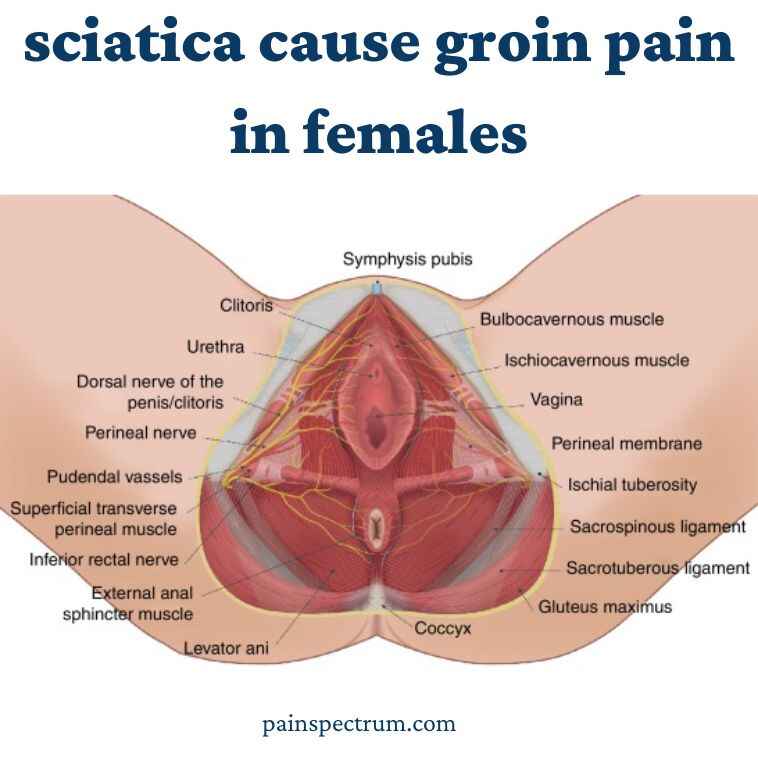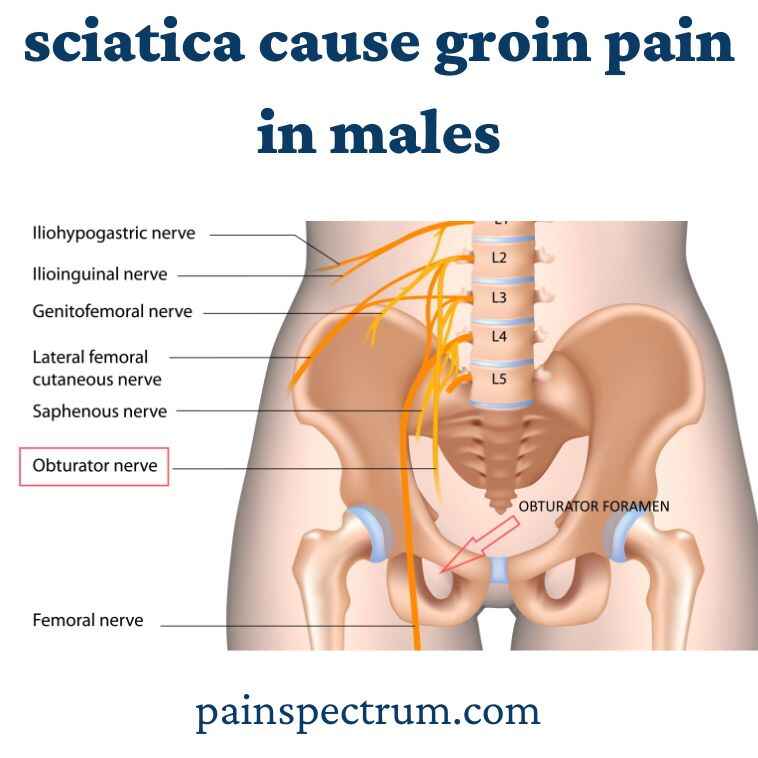
Can Sciatica Cause Groin Pain Best Guide-2024
Last updated on December 12th, 2025 at 04:13 pm
Sciatica is a condition that can cause pain in different parts of the body, including the lower back, legs, and even the hip. If you have hip pain, sciatica might not be the first thing you think of. In this article, we will discuss whether sciatica can cause hip pain. You will also learn what sciatica is, its causes and symptoms, and the best treatments to relieve your pain.
Table of Contents
What is Sciatica?
Sciatica is when the sciatic nerve, which runs from your lower back to your legs, becomes swollen and pressured. This swelling and pressure can cause pain, tingling, numbness, and weakness in your lower back, hips, and legs.
Usually, this condition affects only one side of the body, but in some cases (called bilateral sciatica), it can affect both sides. Sciatica is a common condition that affects about 40% of adults at some point in their lives.
The symptoms of sciatica can range from mild to severe (sometimes sciatica can be so severe that you cannot walk), but in most cases, sciatica does not last long and gets better within a few weeks. Sometimes, if the symptoms do not improve on their own, medical treatment is needed.

Can Sciatica Cause Groin Pain?
Yes, sciatica can cause groin pain. The sciatic nerve can affect any area along its path, including the groin. Sufferers of sciatica may experience pain in their inner thighs, lower abdominal aches, anal pain, and discomfort in and around the genital area. The reason sciatica causes groin pain is the same as why it causes pain and discomfort in other areas it affects: because the nerves are pinched, damaged, or otherwise obstructed, causing errant signals to be shot down the leg.
Other Symptoms of Sciatica
Groin pain is one common symptom of sciatica. If your groin pain is due to sciatica, you may also feel other symptoms.
- Pain down the legs: The sciatic nerve runs down your legs and can cause pain behind or in your legs. If you have sciatica, feeling pain behind or in your legs is very common.
- Tingling, burning, or numbness: With sciatica, the type of pain can vary. You might feel tingling, burning, or numbness. Shooting pain down your legs can also feel like an electric shock. This is a type of nerve pain.
- Weakness in legs or feet: If you feel your leg is weaker than normal or you sometimes stumble on one foot, these could be signs of sciatica. Moving your legs and feet might also be harder because of your sciatic nerve.
- Pain after sitting: Sitting for a long time can make sciatic pain worse. If you feel more pain when you stand up after sitting, it could be a sign of sciatica.
- Coughing or sneezing makes pain worse: Coughing or sneezing can increase pressure around your lower back. This extra pressure can affect your sciatic nerve and make your pain worse.
- Difficulty walking or standing up: Sciatica can make it hard to walk normally or get up from a sitting position. You might feel a sharp pain or weakness in your legs when trying to move.
- Lower back pain: Sciatica often starts in the lower back and radiates down the leg. So, if you have pain in your lower back that travels down your leg, it could be a sign of sciatica.
Different Types of Sciatica Causing Groin Pain
Understanding the different types of sciatica can help in identifying the specific cause of groin pain:
1. Lumbar Sciatica
Lumbar sciatica is the most common form of sciatica and is caused by a herniated disc in the lower back. This condition occurs when the disc bulges out and puts pressure on the sciatic nerve, causing pain to radiate down the leg and into the groin area.
2. Femoral Sciatica
Femoral sciatica occurs when the sciatic nerve is compressed in the area where it passes through the pelvis. This can cause pain in the groin area, as well as the front of the thigh and the inner knee.
3. Cauda Equina Syndrome
Cauda Equina Syndrome is a rare but serious condition that can cause sciatica-like symptoms, including groin pain. It occurs when the bundle of nerves at the end of the spinal cord (cauda equina) is compressed, leading to a range of symptoms, including pain, numbness, and weakness.
4. Piriformis Syndrome
Piriformis syndrome is a condition where the sciatic nerve is compressed by the piriformis muscle, which is located in the buttocks. This can cause pain in the buttocks and down the back of the leg, including the groin area.
5. Sacroiliac Joint Dysfunction
Sacroiliac joint dysfunction occurs when the joint between the sacrum (a bone in the lower back) and the ilium (a bone in the pelvis) becomes misaligned or inflamed. This can cause pain in the lower back, hips, and groin area.
6. Hip Referred Pain
Hip referred pain is a condition where pain originating from the hip joint is felt in the groin area. This can be due to conditions such as hip arthritis, hip fracture, or hip strain.
Causes of Sciatica-Related Groin Pain
The causes of sciatica-related groin pain can vary and are often related to the compression, inflammation, or irritation of the sciatic nerve. Here are the main causes of sciatica-related groin pain:
- Nerve Pressure: Discs or bone growths press on the sciatic nerve, causing groin pain.
- Muscle Tightness: Tight back or buttock muscles compress the sciatic nerve, causing groin pain.
- Piriformis Syndrome: The piriformis muscle squeezes the sciatic nerve, causing groin and leg pain.
- Hip Problems: Arthritis or hip injuries lead to groin pain from sciatica.
- Pain Spread: Sciatica from the lower back sends pain to the groin through nerves.
- Other Issues: Bursitis, tendon problems, or pelvic bone inflammation worsen hip and groin pain from sciatica.
Gynecological Causes
Sciatica can be caused by various factors, including:
- Herniated Disc: A disc in the spine may bulge or herniate, putting pressure on the sciatic nerve.
- Sciatica Pain During Pregnancy: Hormonal changes and increased pressure on the spine during pregnancy can contribute to sciatica.
What is Cauda Equina Syndrome?
Cauda Equina Syndrome is a rare but serious condition that can occur when the sciatic nerve roots at the end of the spinal cord become compressed or damaged. Symptoms include severe lower back pain, difficulty walking, loss of bladder and bowel control, and sexual dysfunction. If you experience these symptoms, seek immediate medical attention.
Can sciatica cause groin pain in females?

Yes, sciatica can cause groin pain in females. Sciatica refers to pain that radiates along the path of the sciatic nerve, which extends from the lower back through the hips and buttocks and down each leg. When the sciatic nerve is irritated or compressed, it can cause pain, numbness, tingling, or weakness that can radiate into the groin area. This can happen due to various reasons such as herniated discs, spinal stenosis, or piriformis syndrome, among others. If you’re experiencing persistent or severe groin pain along with symptoms of sciatica, it’s advisable to consult a healthcare provider for an accurate diagnosis and appropriate treatment.
Can sciatica cause groin pain in males?

Yes, sciatica can cause groin pain in males. Sciatica refers to pain that radiates along the path of the sciatic nerve, which runs from your lower back through your hips and buttocks down each leg. When the sciatic nerve is compressed or irritated, it can cause pain not only in the lower back and buttocks but also radiating down the leg. Sometimes, this pain can extend into the groin area, especially if the sciatic nerve irritation affects the branches of nerves that also supply the groin region.
How to Treat Referred Groin Pain from Sciatica at Home?
For treating sciatica and groin pain, various methods are commonly used. These include non-surgical treatments, minimally invasive options, and sometimes surgery. Working with your healthcare professional and adopting healthy lifestyle practices can help manage your pain and improve your quality of life.
- Regular Exercise: Engaging in low-impact exercises like walking, swimming, or cycling can strengthen your back muscles and improve flexibility and posture. Exercise releases endorphins, which can help manage pain naturally.
- Proper Ergonomics: Using ergonomic furniture and sitting properly can prevent worsening of sciatica and groin pain. This includes using chairs that support your lower back, keeping your feet flat on the floor, and avoiding prolonged sitting or standing.
- Weight Management: Maintaining a healthy weight reduces pressure on your spine and legs, easing strain on sciatic nerves and related structures.
By incorporating these practices and consulting with your healthcare provider, you can effectively manage your pain and enhance your overall well-being.
Medical Treatments for Sciatic Groin Pain
When addressing sciatic groin pain, treatment options generally focus on relieving symptoms and addressing the underlying cause. Here are some medical treatments:
Physiotherapy
Physiotherapy for sciatic groin pain involves managing pain through techniques like heat/cold therapy and massage, stretching key muscles such as the piriformis and hamstrings, and strengthening the core and back muscles to support the spine. It also includes correcting posture, improving flexibility with stretching and foam rolling, and training for better movement patterns. Education on lifestyle changes and activity modifications helps prevent the pain from returning. A physiotherapist will create a personalized plan to address your specific needs.
Diagnostic imaging
For diagnosing sciatic groin pain, doctors use X-rays to check for fractures, MRI scans for detailed images of soft tissues like discs and nerves, and sometimes CT scans for more detailed views of bones and joints. These tests help find the cause so treatment can be planned.
Injections
Injections like epidural steroids or trigger point injections can help relieve sciatic pain that radiates into the groin. They target inflammation or muscle knots causing the pain.
Surgery
Surgery for sciatic groin pain may be needed to relieve pressure on the sciatic nerve caused by conditions like herniated discs or spinal canal narrowing. Surgical options include removing disc material (discectomy), widening the spinal canal (laminectomy), or stabilizing the spine (spinal fusion). The outcomes and benefits vary, so it’s important to consult your doctor to find the best option for you.
Microdiscectomy
Microdiscectomy is a low-pressure surgery used when a disc in your spine presses on your sciatic nerve. During microdiscectomy, the part of the disc causing your symptoms is removed. This procedure is typically done while you are under general anesthesia.
Facetectomy
Fasciectomy means cutting or removing the connective tissue between the bones of your spine, where nerves pass through. Over time, arthritis can affect these facet joints (the joints between spinal bones), causing pressure on your sciatic nerve.
During a fasciectomy, the facet joints are operated on to reduce pressure on the sciatic nerve and relieve pain in the facet joints.
Foraminotomy
Foraminotomy means creating more space in the openings between the bones in your spine where nerves exit. These openings are called neural foramina. When they become narrow due to conditions like osteoarthritis, they can put pressure on the nerves as they exit the spine.
In foraminotomy, surgeons remove extra bone growth that’s narrowing these openings. This procedure helps the spinal nerves exit without being squeezed, reducing pressure on them.
Laminectomy
In laminectomy, there’s a roof-like cover over your spine. It supports your spine’s curve and keeps its center safe. During laminectomy, part or all of this cover is removed to ease pressure on the spinal nerves.
Exercises for Sciatica and Groin Pain Relief
Here are some of the most effective exercises and stretches recommended for relieving sciatica and associated groin pain:
Groin Stretch
- Technique: Lie flat on your back, bring your feet together and let your knees drop out to the sides in a butterfly position. This stretches the inner thigh adductors and groin area.
- Duration: Hold for 30 seconds and repeat 3 times.
Buttocks and Hip Stretch
- Technique: Lie on the floor, bend both knees and place one ankle over the opposite knee, forming a “figure 4”. Gently pull the other leg towards your chest until you feel a stretch in your buttocks and hip.
- Duration: Hold for 30 seconds and repeat 3 times.
Knee-to-Chest Stretch
- Technique: Lie flat on your back, bend one knee and bring it towards your chest. Hold the position for 30 seconds before switching legs.
- Duration: Repeat 3 times on each side.
Yoga Poses for Sciatica and Groin Pain Relief
Yoga poses can be particularly helpful in relieving sciatica and groin pain. Poses such as the child’s pose, pigeon pose, and downward dog can help stretch and strengthen the muscles supporting the lower back and hips.
Read more: Last Stages of Sciatica Best Guide
When to Seek Medical Advice
If your groin pain persists or worsens, or if you experience other symptoms such as numbness, tingling, or weakness in the legs, it is crucial to seek medical advice. Early diagnosis and treatment can help prevent further complications.
FAQs
Are there specific exercises to help relieve sciatica pain in the groin?
Gentle stretching exercises that target the lower back, buttocks, and legs can help alleviate sciatica pain that radiates to the groin. Examples include pelvic tilts, knee-to-chest stretches, and yoga poses like the pigeon pose.
How long does groin pain from sciatica last?
The duration of groin pain from sciatica can vary. It may last from a few days to several weeks, depending on the severity of the nerve compression and how well it responds to treatment and rest.
What are ways to relieve groin pain from sciatica?
You can relieve groin pain from sciatica by practicing good posture, avoiding prolonged sitting or standing, applying ice or heat packs to the affected area, and taking over-the-counter pain relievers. Physical therapy and gentle exercise can also help.
Can sciatica cause vulvar pain?
Yes, sciatica can cause pain that radiates to the vulva in some cases. The pain may feel like a shooting or burning sensation and is due to the irritation of the sciatic nerve affecting nearby areas.
Can sciatica cause swollen lymph nodes in the groin?
Sciatica itself does not typically cause swollen lymph nodes in the groin. Swollen lymph nodes in this area are more likely due to an infection or inflammation elsewhere in the body and should be evaluated by a healthcare provider.
Can sciatica cause hip and groin pain?
Sciatica can cause pain in the hip and groin. Sciatica is well-known for causing pain from the lower back down to the legs, but it can also lead to pain in the hip and groin areas. The sciatic nerve is the longest in the body, running from the lower back through the hips down to each leg. When this nerve is compressed or irritated, it can cause pain not only along its usual path but also in nearby areas like the groin and hips. This happens because the roots of the sciatic nerve that connect to it also serve the areas around the groin and hips.
Conclusion
In conclusion, while sciatica can cause groin pain, it is essential to consult a healthcare professional to rule out other potential causes and receive appropriate treatment. By combining medical treatments with home remedies and exercises, you can manage your symptoms and improve your quality of life.


